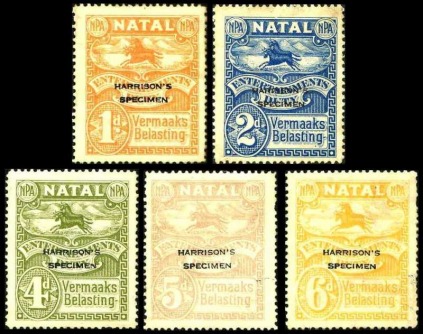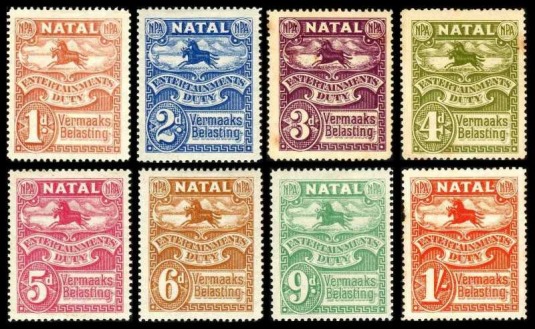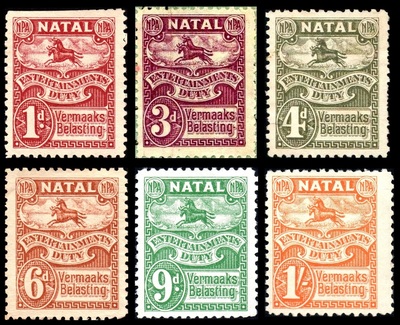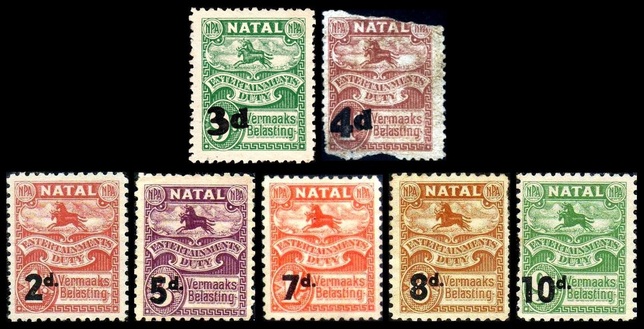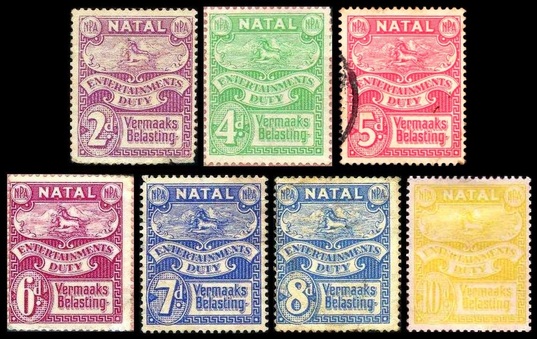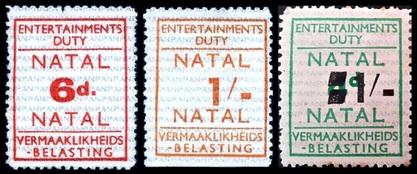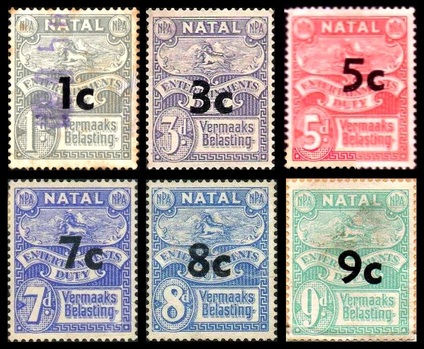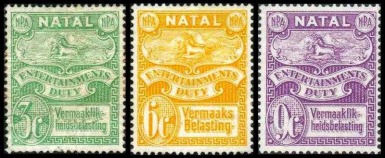South Africa - Entertainments Duty (Natal)
Acknowledgments for this section can be found on the main Southern Africa page.
Currency
- (1917-1961) 20 shillings = 1 South African pound (12 pence = 1 shilling)
- (1961-) 100 cents = 1 South African rand
All the Entertainments Duty stamps of Natal are inscribed bilingually, with English and Afrikaans appearing on each stamp.
1917. Rouletted. No watermark. Two different types of the design exist (see note below).
1917. Rouletted. No watermark. Two different types of the design exist (see note below).
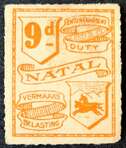 E5A
E5A
Type A.
E1A. 1d red
E2A. 2d blue
E3A. 3d purple-brown
E4A. 6d yellowish green
E5A. 9d orange
E6A. 1s mauve
Type B.
E1B. 1d red
E2B. 2d blue
E3B. 3d purple-brown
E4B. 6d green
E6B. 1s mauve
E1A. 1d red
E2A. 2d blue
E3A. 3d purple-brown
E4A. 6d yellowish green
E5A. 9d orange
E6A. 1s mauve
Type B.
E1B. 1d red
E2B. 2d blue
E3B. 3d purple-brown
E4B. 6d green
E6B. 1s mauve
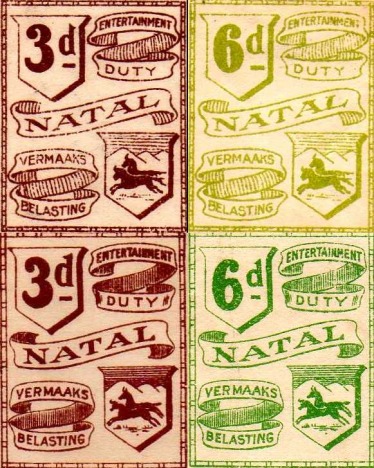
3d and 6d showing Types A (top) and B (bottom)
Notes:
1. It seems likely that types A and B represent different printings rather than being from different positions in the same sheet. The two types are easily distinguished from each other, type B having generally a better executed design than type A (see enlarged illustrations at right). In type B the scrolls have a more regular shape than in type A, the wildebeest are better defined, and the lines of shading are finer and more closely spaced. Additionally the letter 'd' in the value tablet has a serif pointing right (A) or left (B); the letters 'AL' of NATAL are joined only in type A; and there is shading on the scroll either side of the word DUTY only in type B.
1. It seems likely that types A and B represent different printings rather than being from different positions in the same sheet. The two types are easily distinguished from each other, type B having generally a better executed design than type A (see enlarged illustrations at right). In type B the scrolls have a more regular shape than in type A, the wildebeest are better defined, and the lines of shading are finer and more closely spaced. Additionally the letter 'd' in the value tablet has a serif pointing right (A) or left (B); the letters 'AL' of NATAL are joined only in type A; and there is shading on the scroll either side of the word DUTY only in type B.
2. Dickson & Palazzo (2006) suggest that these stamps were issued in 1917, since Natal's first Inspectors of Entertainments Duty were appointed on 1st October in that year.
3. Shades of all values are known.
4. Barefoot also lists a 4d but I have not seen this.
3. Shades of all values are known.
4. Barefoot also lists a 4d but I have not seen this.
In the autumn of 1923 the South African High Commission in London invited a number of printing firms to submit new Entertainment Duty designs, and to quote for printing a total of 500,000 stamps denominated between 1d and 1s.
Bradbury Wilkinson and De La Rue each submitted three essays as shown above, BW's all being dated 21 September 1923. De La Rue additionally submitted a watermark essay showing the letters ED (=Entertainments Duty) in large capitals.
All the essays submitted by Bradbury Wilkinson and De La Rue were rejected. It is not known which other printers submitted designs, and no other surviving essays are known. It seems likely that the successful design was by Harrison, since a part set of stamps in the accepted design is known overprinted HARRISON'S SPECIMEN (see illustration below). These are printed in issued or near-issued colours and are perforated 13¾ all round, and are presumed to be essay samples or colour trials. If this is correct, then it seems likely that the issued stamps perforated 13¾ (E11/18) are also the work of Harrison.
Bradbury Wilkinson and De La Rue each submitted three essays as shown above, BW's all being dated 21 September 1923. De La Rue additionally submitted a watermark essay showing the letters ED (=Entertainments Duty) in large capitals.
All the essays submitted by Bradbury Wilkinson and De La Rue were rejected. It is not known which other printers submitted designs, and no other surviving essays are known. It seems likely that the successful design was by Harrison, since a part set of stamps in the accepted design is known overprinted HARRISON'S SPECIMEN (see illustration below). These are printed in issued or near-issued colours and are perforated 13¾ all round, and are presumed to be essay samples or colour trials. If this is correct, then it seems likely that the issued stamps perforated 13¾ (E11/18) are also the work of Harrison.
1923-1940s. Black and blue wildebeest, taken from the Arms of the Province. Size approx 24 x 30½ mm, varying slightly from one printing to another. No watermark. Various perfs and printers. Sheets of 50 (5 rows of 10).
a) 1923. Perf 13¾. Probably printed by Harrison (see note above).
E11. 1d brick-red
E12. 2d blue
E13. 3d deep purple
E14. 4d olive-green
E15. 5d rose
E16. 6d brown
E17. 9d blue-green
E18. 1s red-orange
Notes:
1. Stamps of this design exist in no fewer than nine different perforations, which suggests the work of a number of different printers. Only De La Rue and Harrison are known with certainty to have been involved, and the correspondence of printers to perforations has not yet been established. Surviving records from the De La Rue archive shows that the South African High Commission kept the printing plates and put each new requirement for stamps out to tender, and therefore it is conceivable that each contract was won by a different printer with no continuity. Dickson & Palazzo suggest that the printing of Natal Entertainment stamps may have been transferred to the South African Government Printer in the 1930s, along with the printing of all South African postage stamps.
2. Numbers have been set aside in the listing below to allow for additional values in each of the different perforations. Perforations are quoted to the nearest quarter as an aid to identification.
3. For the 7d and 2s3d in this design but perf 11, see E78/79 below. Barefoot additionally lists a 10d yellow value, which I have not seen except from the Pretoria printing (see my E130 below).
4. Imperforate plate proofs are known of E11/18, though not of the later additions (E78/79).
E11. 1d brick-red
E12. 2d blue
E13. 3d deep purple
E14. 4d olive-green
E15. 5d rose
E16. 6d brown
E17. 9d blue-green
E18. 1s red-orange
Notes:
1. Stamps of this design exist in no fewer than nine different perforations, which suggests the work of a number of different printers. Only De La Rue and Harrison are known with certainty to have been involved, and the correspondence of printers to perforations has not yet been established. Surviving records from the De La Rue archive shows that the South African High Commission kept the printing plates and put each new requirement for stamps out to tender, and therefore it is conceivable that each contract was won by a different printer with no continuity. Dickson & Palazzo suggest that the printing of Natal Entertainment stamps may have been transferred to the South African Government Printer in the 1930s, along with the printing of all South African postage stamps.
2. Numbers have been set aside in the listing below to allow for additional values in each of the different perforations. Perforations are quoted to the nearest quarter as an aid to identification.
3. For the 7d and 2s3d in this design but perf 11, see E78/79 below. Barefoot additionally lists a 10d yellow value, which I have not seen except from the Pretoria printing (see my E130 below).
4. Imperforate plate proofs are known of E11/18, though not of the later additions (E78/79).
b) Perf 13¾ compound 11
E22. 2d blue
E24. 4d olive-green
E26. 6d brown
Notes:
1. These stamps are perf 13¾ all round, except for three much wider perforations (gauge 11) in the horizontal rows.
2. The fact that stamps of this perforation can be found se-tenant with the ordinary perf 13¾ stamps shows that they are not from a separate printing but from a single vertical column on the normal sheet.
3. The existence of Harrison's samples in the same perf (illustrated above) suggests that the perforating comb included these wide perforations from the very beginning. It is likely therefore that all stamps known in perf 13¾ should also occur with this compound perf.
E22. 2d blue
E24. 4d olive-green
E26. 6d brown
Notes:
1. These stamps are perf 13¾ all round, except for three much wider perforations (gauge 11) in the horizontal rows.
2. The fact that stamps of this perforation can be found se-tenant with the ordinary perf 13¾ stamps shows that they are not from a separate printing but from a single vertical column on the normal sheet.
3. The existence of Harrison's samples in the same perf (illustrated above) suggests that the perforating comb included these wide perforations from the very beginning. It is likely therefore that all stamps known in perf 13¾ should also occur with this compound perf.
c) Perf 14¼
E32. 2d blue
E34. 4d olive-green
E36. 6d red-brown
E38. 1s red-orange
E32. 2d blue
E34. 4d olive-green
E36. 6d red-brown
E38. 1s red-orange
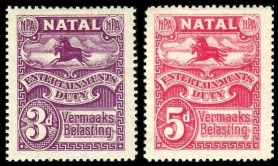
E43, 45
d) Perf 13¼
E43. 3d deep purple
E45. 5d rose
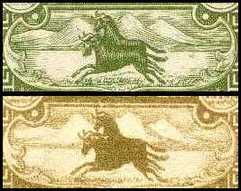 Normal impression (top) and coarser perf 12½ printing (below)
Normal impression (top) and coarser perf 12½ printing (below)
e) Perf 12½
E51. 1d brick-red
E52. 2d blue
E53. 3d deep purple
E54. 4d olive-bistre
E55. 5d rose
Notes:
1. Stamps of this perforation have a coarser impression than other printings (see illustration at right), and a narrower margin between the design and the perforations. This suggests a different printer and/or method of printing.
2. An example of E55 is known on a 2s6d cinema ticket, proving that these stamps were issued before 1940.
3. The 7d value formerly listed with this set has been deleted since the perforation of the example I saw has been confirmed as perf 11 (see E78 below).
E51. 1d brick-red
E52. 2d blue
E53. 3d deep purple
E54. 4d olive-bistre
E55. 5d rose
Notes:
1. Stamps of this perforation have a coarser impression than other printings (see illustration at right), and a narrower margin between the design and the perforations. This suggests a different printer and/or method of printing.
2. An example of E55 is known on a 2s6d cinema ticket, proving that these stamps were issued before 1940.
3. The 7d value formerly listed with this set has been deleted since the perforation of the example I saw has been confirmed as perf 11 (see E78 below).
f) Rough perf 11¼
E61. 1d brick-red
E62. 2d blue
E63. 3d deep purple
E64. 4d brown-olive
E65. 5d deep rose
E66. 6d brown
E67. 9d blue-green
E61. 1d brick-red
E62. 2d blue
E63. 3d deep purple
E64. 4d brown-olive
E65. 5d deep rose
E66. 6d brown
E67. 9d blue-green
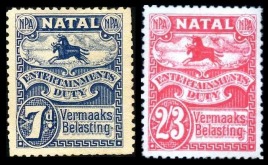
E78/79
g) c1940. Clean-cut perf 11.
E78. 7d deep ultramarine
E79. 2s3d rose-pink
Note: an issue date of 1940 is suggested by the fact that a 7d rate was introduced in that year.
h) Perf 10
E81. 1d brick-red
E83. 3d deep purple
E84. 4d olive-green
E86. 6d brown
E87. 9d blue-green
E88. 1s red-orange
E81. 1d brick-red
E83. 3d deep purple
E84. 4d olive-green
E86. 6d brown
E87. 9d blue-green
E88. 1s red-orange

E94
j) Perf 9
E94. 4d olive-green
1940. Previous issue surcharged with symbols cancelling the original value, and new value printed alongside. Perf 13¾.
a) Surcharged in blue-black with a five-pointed star cancelling the original value
E101. 6d on 2d blue
E102. 9d on 2d blue
E103. 1s on 2d blue
b) Surcharged in black with a floral motif cancelling the original value
E105. 7d on 2d blue
E106. 7d on 5d rose
The need for the above surcharges was probably occasioned by the rate change of 17th June 1940. Ordinance No 9 withdrew the 2d and 5d rates, so stamps of these values were surcharged to provide other values. At the same time a new 7d rate was introduced, while the existing 6d and 1s rates continued in use.
a) Surcharged in blue-black with a five-pointed star cancelling the original value
E101. 6d on 2d blue
E102. 9d on 2d blue
E103. 1s on 2d blue
b) Surcharged in black with a floral motif cancelling the original value
E105. 7d on 2d blue
E106. 7d on 5d rose
The need for the above surcharges was probably occasioned by the rate change of 17th June 1940. Ordinance No 9 withdrew the 2d and 5d rates, so stamps of these values were surcharged to provide other values. At the same time a new 7d rate was introduced, while the existing 6d and 1s rates continued in use.
c1945 (see note 3). Earlier issues surcharged with the new value printed over the original value.
a) Perf 10: new value in very thick seriffed font
E107. 3d on 9d green
E108. 4d on 1d purple-brown
b) Perf 9: new value in bold sans-serif font
E111. 2d on 1d brick-red
E112. 5d on 3d deep purple
E113. 7d on 1s red-orange
E114. 8d on 6d red-brown
E115. 10d on 9d green
Notes:
1. Barefoot additionally lists a 10d on 10d surcharge, though I suspect this may be an error.
2. E111/115 are not known in perf 9 without surcharge.
3. It seems likely that E111/115 were issued following Ordinance No 7 of 27th June 1945. At that time the 1d, 3d, 6d and 9d rates were withdrawn, new rates of 8d and 10d were introduced, 4d and 7d rates continued, and the pre-1940 rates of 2d and 5d were brought back.
a) Perf 10: new value in very thick seriffed font
E107. 3d on 9d green
E108. 4d on 1d purple-brown
b) Perf 9: new value in bold sans-serif font
E111. 2d on 1d brick-red
E112. 5d on 3d deep purple
E113. 7d on 1s red-orange
E114. 8d on 6d red-brown
E115. 10d on 9d green
Notes:
1. Barefoot additionally lists a 10d on 10d surcharge, though I suspect this may be an error.
2. E111/115 are not known in perf 9 without surcharge.
3. It seems likely that E111/115 were issued following Ordinance No 7 of 27th June 1945. At that time the 1d, 3d, 6d and 9d rates were withdrawn, new rates of 8d and 10d were introduced, 4d and 7d rates continued, and the pre-1940 rates of 2d and 5d were brought back.
1945. Smaller type, 21½ x 27 mm. Perf 14. No watermark. Printed (screened rotogravure) by the Government Printer, Pretoria.
[E121. 1d grey]
E122. 2d mauve
[E123. 3d violet]
E124. 4d emerald
E125. 5d bright rose
E126. 6d claret
E127. 7d ultramarine
E128. 8d turquoise-blue
[E129. 9d blue-green]
E130. 10d orange-yellow
Notes:
1. The 1d, 3d and 9d values are currently known only with decimal surcharge (see E141/142 and E146 below), but it seems likely that they were originally issued without.
2. The date of issue is suggested by Dickson & Palazzo (2006) on the basis that the 8d rate was introduced in 1945, while rates of 2d, 4d, 5d and 7d continued in use at the same time. The 1d and 6d rates were withdrawn in 1945 and only brought back in the late 1950s, so perhaps E121 and E125 were late additions to the set. The need for a 9d stamp is not at all clear since this rate was withdrawn in 1940 and never re-introduced.
[E121. 1d grey]
E122. 2d mauve
[E123. 3d violet]
E124. 4d emerald
E125. 5d bright rose
E126. 6d claret
E127. 7d ultramarine
E128. 8d turquoise-blue
[E129. 9d blue-green]
E130. 10d orange-yellow
Notes:
1. The 1d, 3d and 9d values are currently known only with decimal surcharge (see E141/142 and E146 below), but it seems likely that they were originally issued without.
2. The date of issue is suggested by Dickson & Palazzo (2006) on the basis that the 8d rate was introduced in 1945, while rates of 2d, 4d, 5d and 7d continued in use at the same time. The 1d and 6d rates were withdrawn in 1945 and only brought back in the late 1950s, so perhaps E121 and E125 were late additions to the set. The need for a 9d stamp is not at all clear since this rate was withdrawn in 1940 and never re-introduced.
1950s? New numeral types, with security underprint of multiple letters NPA in blue. E133 is surcharged in black with two thick horizontal bars cancelling the original face value.
E131. 6d carmine
E132. 1s orange
E133. 1s on 4d green
Notes:
1. The date of issue is unknown, but it must presumably pre-date the introduction of decimal currency in 1961.
2. The 4d value is known only with the one shilling surcharge but presumably was originally issued without.
E131. 6d carmine
E132. 1s orange
E133. 1s on 4d green
Notes:
1. The date of issue is unknown, but it must presumably pre-date the introduction of decimal currency in 1961.
2. The 4d value is known only with the one shilling surcharge but presumably was originally issued without.
c1961. As 1945 issue but surcharged in decimal currency.
E141. 1c on 1d grey
E142. 3c on 3d violet
E143. 5c on 5d bright rose
E144. 7c on 7d ultramarine
E145. 8c on 8d turquoise-blue
E146. 9c on 9d blue-green
According to Palazzo (2010), these stamps were issued when Ordinance No 28 of 1960 came into force on 14th February 1961, providing for a decimal duty on cinema tickets.
The 1d, 3d and 9d values are not recorded without surcharge.
E141. 1c on 1d grey
E142. 3c on 3d violet
E143. 5c on 5d bright rose
E144. 7c on 7d ultramarine
E145. 8c on 8d turquoise-blue
E146. 9c on 9d blue-green
According to Palazzo (2010), these stamps were issued when Ordinance No 28 of 1960 came into force on 14th February 1961, providing for a decimal duty on cinema tickets.
The 1d, 3d and 9d values are not recorded without surcharge.
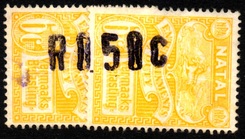 E152 with handstamp surcharge or cancel (see note)
E152 with handstamp surcharge or cancel (see note)
1960s? As 1945 issue but value in decimal currency. Lower panel inscribed Vermaaks Belasting (6c) or Vermaaklik-heidsbelasting (others).
E151. 3c emerald
E152. 6c yellow-orange
E153. 9c violet
Note:
The two overlapping examples of E152 illustrated above right have what appears to be a surcharge R0.50c (or possibly R1.50c) applied with a rubber handstamp. The handstamp runs across both stamps together in the manner of a cancel. I have not seen another example and would be glad to hear from any reader who can shed more light on these.
E151. 3c emerald
E152. 6c yellow-orange
E153. 9c violet
Note:
The two overlapping examples of E152 illustrated above right have what appears to be a surcharge R0.50c (or possibly R1.50c) applied with a rubber handstamp. The handstamp runs across both stamps together in the manner of a cancel. I have not seen another example and would be glad to hear from any reader who can shed more light on these.



